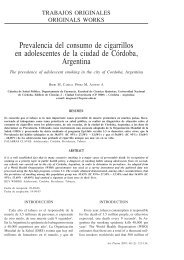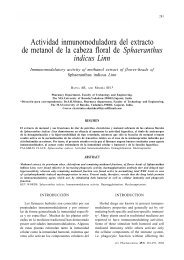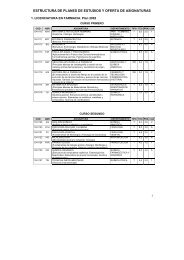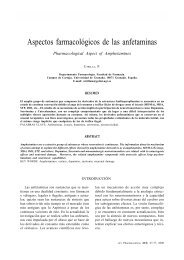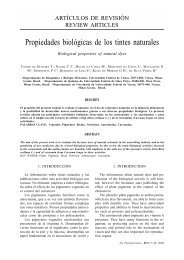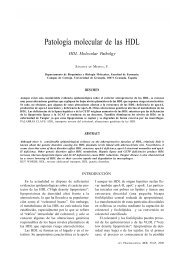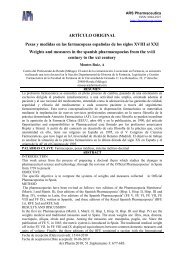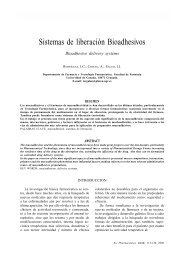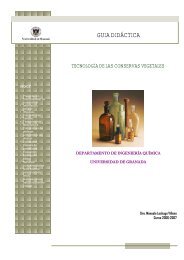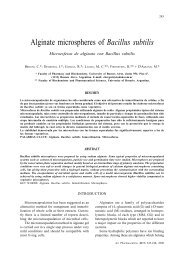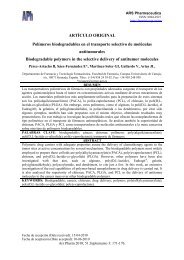Identificación in silico, caracterización molecular y análisis de ...
Identificación in silico, caracterización molecular y análisis de ...
Identificación in silico, caracterización molecular y análisis de ...
You also want an ePaper? Increase the reach of your titles
YUMPU automatically turns print PDFs into web optimized ePapers that Google loves.
IDENTIFICACIÓN IN SILICO, CARACTERIZACIÓN MOLECULAR Y ANÁLISIS DE EXPRESIÓN DE LA PROTEÍNA...<br />
SILICO IDENTIFICATION, MOLECULAR CHARACTERIZATION AND EXPRESSION ANALYSIS OF THE TRYPANOSOMA...<br />
presentan una elevada <strong>in</strong>munogenicidad que<br />
<strong>in</strong>duce una respuesta celular protectora 10,11 . Recientemente,<br />
se ha <strong>de</strong>scrito que la <strong>in</strong>munización<br />
<strong>de</strong> ratones con las proteínas recomb<strong>in</strong>antes<br />
PFR3 y PFR2 <strong>de</strong> T. cruzi proporciona<br />
<strong>in</strong>munidad protectora frente a la <strong>in</strong>fección por<br />
T. cruzi 12 . Los <strong>análisis</strong> Western blot realizados<br />
con lisados <strong>de</strong> T. brucei sugieren que podría<br />
existir un homólogo <strong>de</strong>l PFR3 en T. brucei,<br />
dado que se ha observado reactividad cruzada<br />
con un anticuerpo monoclonal PFR3 <strong>de</strong> T.<br />
cruzi 9 . En el presente artículo se <strong>de</strong>scribe el<br />
aislamiento <strong>de</strong>l gen codificante <strong>de</strong> la proteína<br />
PFR3 <strong>de</strong> T. brucei, que es homóloga a la PFR3<br />
<strong>de</strong> T. cruzi. También analizamos el número<br />
<strong>de</strong> copias <strong>de</strong>l gen presente en el genoma <strong>de</strong><br />
T. brucei y se muestra el producto <strong>de</strong> su expresión<br />
tanto en formas procíclicas como <strong>de</strong><br />
torrente sanguíneo <strong>de</strong>l parásito.<br />
2. MATERIALES Y MÉTODOS<br />
Análisis Análisis Análisis Análisis Análisis bio<strong>in</strong>formático: bio<strong>in</strong>formático<br />
bio<strong>in</strong>formático<br />
bio<strong>in</strong>formático<br />
bio<strong>in</strong>formático Para <strong>in</strong>vestigar<br />
la existencia <strong>de</strong> homólogos <strong>de</strong> PFR3 en el<br />
genoma <strong>de</strong> T. brucei y Leishmania major, hemos<br />
aprovechado el proyecto <strong>de</strong>l genoma <strong>de</strong> estos<br />
parásitos. Se realizaron búsquedas BLAST en<br />
la base <strong>de</strong> datos <strong>de</strong>l proyecto <strong>de</strong>l genoma <strong>de</strong>l<br />
T. brucei <strong>de</strong>positadas en el banco <strong>de</strong> genes<br />
Genbank <strong>de</strong>l NCBI (http://www.ncbi.<br />
nlm.nih.gov), así como la base <strong>de</strong> datos GSS<br />
<strong>de</strong>l T. brucei <strong>de</strong>l EMBL-EBI (http://www.ebi.<br />
ac.uk/blast2/parasites.html). Ambas bases <strong>de</strong><br />
datos abarcan más <strong>de</strong>l 50% <strong>de</strong>l genoma <strong>de</strong>l<br />
parásito T. brucei, basándose en un contenido<br />
<strong>de</strong> ADN <strong>de</strong> Mb por genoma haploi<strong>de</strong>13 . Por<br />
otra parte, las secuencias <strong>de</strong> Leishmania major<br />
<strong>de</strong>positadas en el EMBL-EBI abarcan más<br />
<strong>de</strong>l 50 % <strong>de</strong>l genoma <strong>de</strong>l parásito, basándose<br />
en un contenido <strong>de</strong> ADN <strong>de</strong> 35 Mb por genoma<br />
haploi<strong>de</strong>13 .<br />
Parásitos: Parásitos: Parásitos: Parásitos: Parásitos: Se utilizaron formas procíclicas<br />
y <strong>de</strong> torrente sanguíneo <strong>de</strong> la cepa monomórfica<br />
427 <strong>de</strong> T. brucei (Molteno Institute<br />
Trypanozoon tipo antigénico 1.2 (MITat 1.2)<br />
clon 221a) 14 .<br />
Análisis Análisis Análisis Análisis Análisis <strong>de</strong> <strong>de</strong> <strong>de</strong> <strong>de</strong> <strong>de</strong> restricción restricción restricción restricción restricción y y y y y aislamiento<br />
aislamiento<br />
aislamiento<br />
aislamiento<br />
aislamiento<br />
en en en en en T. T. T. T. T. brucei brucei brucei brucei brucei <strong>de</strong>l <strong>de</strong>l <strong>de</strong>l <strong>de</strong>l <strong>de</strong>l gen gen gen gen gen homólogo homólogo homólogo homólogo homólogo al al al al al PFR3 PFR3 PFR3 PFR3 PFR3<br />
<strong>de</strong>T. <strong>de</strong>T. <strong>de</strong>T. <strong>de</strong>T. <strong>de</strong>T. cruzi: cruzi: cruzi: cruzi: cruzi: El ADN <strong>de</strong>l genoma <strong>de</strong> T. bru-<br />
<strong>in</strong> T. brucei given that cross-reactivity with a<br />
T. cruzi PFR3 monoclonal antibody has been<br />
observed 9 . In the present paper we <strong>de</strong>scribe<br />
the isolation of the gene cod<strong>in</strong>g for T. brucei<br />
PFR3 prote<strong>in</strong> which is homologous to PFR3<br />
from T. cruzi. We also analyze the copy number<br />
of the gene present <strong>in</strong> T. brucei genome<br />
and show its expression product both <strong>in</strong> procyclic<br />
and bloodstream forms of the parasite.<br />
2. MATERIAL AND METHODS<br />
Bio<strong>in</strong>formatic Bio<strong>in</strong>formatic Bio<strong>in</strong>formatic Bio<strong>in</strong>formatic Bio<strong>in</strong>formatic analysis: analysis analysis analysis analysis To <strong>in</strong>vestigate<br />
the existence of PFR3 homologues <strong>in</strong> the<br />
genome of T. brucei and Leishmania major,<br />
we took advantage of the genome project of<br />
these parasites. BLAST searches were performed<br />
at the T. brucei genome project database<br />
<strong>de</strong>posited <strong>in</strong> Genbank at NCBI (http://<br />
www.ncbi.nlm.nih.gov) as well as <strong>in</strong> EMBL-<br />
EBI T. brucei GSS database (http://www.ebi.ac.<br />
uk/blast2/parasites.html). Both databases cover<br />
over 50% of the T. brucei parasite genome,<br />
based on a DNA content of 40 Mb per<br />
haploid genome13 . On the other hand, Leishmania<br />
major sequences <strong>de</strong>posited at EMBL-<br />
EBI covers more than 50 % of the parasite<br />
genome, based on a DNA content of 35 Mb<br />
per haploid genome13 .<br />
Parasites: Parasites: Parasites: Parasites: Parasites: T. brucei monomorphic stra<strong>in</strong><br />
427 procyclic and bloodstream forms (Molteno<br />
Institute Trypanozoon antigenic type 1.2<br />
(MITat 1.2) clone 221a) were used14 .<br />
Isolation Isolation Isolation Isolation Isolation and and and and and restriction restriction restriction restriction restriction analysis analysis analysis analysis analysis of of of of of<br />
PFR3-like PFR3-like PFR3-like PFR3-like PFR3-like gene gene gene gene gene from from from from from T. T. T. T. T. brucei: brucei brucei brucei brucei T. brucei<br />
genomic DNA was isolated by standard methods15<br />
. Subsequently, PCR was carried out<br />
us<strong>in</strong>g T. brucei genomic DNA as template and<br />
P1Tb5 (5´CAAGGATCCAAACATG ATG ATGATCGA-<br />
ATG<br />
GGTGCAAC3´) and P1Tb3 (5´TCTCTAGA-<br />
ATTTGCCCTCTA CTA CTACCCACGACCG CTA<br />
3’) oligonucleoti<strong>de</strong>s,<br />
which map, respectively, at the<br />
beg<strong>in</strong>n<strong>in</strong>g and the end of T. brucei PFR3-like<br />
cod<strong>in</strong>g gene and conta<strong>in</strong> respectively the start<br />
and stop codons (bold letters). The DNA amplified<br />
fragment was isolated and characterized<br />
by restriction mapp<strong>in</strong>g and by sequenc<strong>in</strong>g<br />
after its clon<strong>in</strong>g <strong>in</strong> pGEM-T vector<br />
(Promega).<br />
75<br />
Ars Pharm 2005; 46 (1): 73-84



